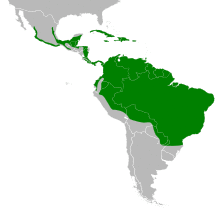| Ruddy quail-dove | |
|---|---|
 | |
| Scientific classification | |
| Kingdom: | Animalia |
| Phylum: | Chordata |
| Class: | Aves |
| Order: | Columbiformes |
| Family: | Columbidae |
| Genus: | Geotrygon |
| Species: | G. montana |
| Binomial name | |
| Geotrygon montana (Linnaeus, 1758) | |
 | |
| Synonyms | |
| Columba montana Linnaeus, 1758 | |
The ruddy quail-dove (Geotrygon montana) is a species of bird in the dove and pigeon family Columbidae. It breeds throughout the West Indies, Central America, and tropical South America. It has appeared as a vagrant in Florida and southern Texas. It lays two buff-colored eggs on a flimsy platform built on a shrub. Some nests are built on the ground.
Description
The ruddy quail-dove is approximately 19–28 cm in length. The bird is distinguished by having a rust-colored back, facial mask and similarly colored wings. The breast, rump and undereye stripe are lighter brown.
Habitat
This bird is found in woodland and scrub forest. It also has adapted to coffee plantations. It is somewhat sensitive to forest fragmentation. These birds forage on the ground, mainly eating seeds. It will also take small invertebrates in its diet.
Taxonomy
In the first half of the 18th century the ruddy quail-dove was described and illustrated by several naturalists including John Ray in 1713,[2] Hans Sloane in 1725[3] and George Edwards in 1743.[4] When in 1758 the Swedish naturalist Carl Linnaeus updated his Systema Naturae for the tenth edition, he placed the ruddy quail-dove with all the other pigeons in the genus Columba. Linnaeus included a brief description, coined the binomial name Columba montana and cited the earlier authors.[5] The specific epithet is from the Latin montanus meaning "of the mountains".[6] The species is now placed in the genus Geotrygon that was introduced in 1847 by the English naturalist Philip Henry Gosse.[7][8]
Two subspecies are recognised:[8]
- G. m. martinica (Linnaeus, 1766) – Lesser Antilles
- G. m. montana (Linnaeus, 1758) – Mexico to northeast Argentina, Greater Antilles, Trinidad
See also
References
- ^ BirdLife International (2012). "Geotrygon montana". IUCN Red List of Threatened Species. 2012. Retrieved 26 November 2013.
- ^ Ray, John (1713). Synopsis methodica avium & piscium (in Latin). London: William Innys. p. 183.
- ^ Sloane, Hans (1725). A Voyage to the Islands Madera, Barbados, Nieves, S. Christophers and Jamaica : with the natural history of the herbs and trees, four-footed beasts, fishes, birds, insects, reptiles, &c. of the last of those islands. Volume 2. London: Printed for the author. p. 304, Plate 261.
- ^ Edwards, George (1743). A Natural History of Uncommon Birds. London: Printed for the author, at the College of Physicians. p. 119 Plate 119.
- ^ Linnaeus, Carl (1758). Systema Naturae per regna tria naturae, secundum classes, ordines, genera, species, cum characteribus, differentiis, synonymis, locis (in Latin). Volume 1 (10th ed.). Holmiae:Laurentii Salvii. p. 163.
- ^ Jobling, James A. (2010). The Helm Dictionary of Scientific Bird Names. London: Christopher Helm. p. 259. ISBN 978-1-4081-2501-4.
- ^ Gosse, Philip Henry (1847). The Birds of Jamaica. London: J. Van Voorst. p. 316.
- ^ a b Gill, Frank; Donsker, David; Rasmussen, Pamela, eds. (2020). "Pigeons". IOC World Bird List Version 10.1. International Ornithologists' Union. Retrieved 20 March 2020.
| External audio | |
|---|---|
| Bird Call | |
- "National Geographic" Field Guide to the Birds of North America ISBN 0-7922-6877-6
- Handbook of the Birds of the World Vol 4, Josep del Hoyo editor, ISBN 84-87334-22-9
